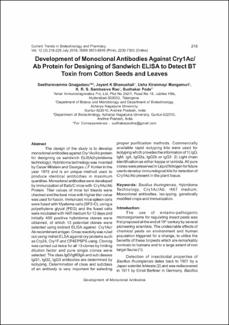Mostrar el registro sencillo del ítem
Development of Monoclonal Antibodies Against Cry1Ac/Ab Protein for Designing of Sandwich ELISA to Detect BT Toxin from Cotton Seeds and Leaves
| dc.contributor.author | Seetharavamma, Gnagadasu | |
| dc.contributor.author | Jayant K, Bhanushali | |
| dc.contributor.author | Kiranmayi, Mangamuri Usha | |
| dc.contributor.author | Sambasiva, Rao K. R. S. | |
| dc.contributor.author | Poda, Sudhakar | |
| dc.date.accessioned | 2020-06-16T03:45:13Z | |
| dc.date.available | 2020-06-16T03:45:13Z | |
| dc.date.issued | 2019-12-30 | |
| dc.identifier.issn | 2230-7303 | |
| dc.identifier.uri | http://repositorio-indicasat.org.pa/handle/123456789/77 | |
| dc.description | The design of the study is to develop monoclonal antibodies against Cry1Ac/Ab protein for designing os sandwich ELISA(hybridoma technology). Hybridoma technology was invented by Cesar Milstein and Georges J.F Kohler in the year 1975 and is an unique method used to produce identical antibodies in maximum quantities. Monoclonal antibodies were developed by immunization of Balb/C mice with Cry1Ac/Ab Protein. Titer values of mice tail bleeds were checked and the best mice with higher titer value was used for fusion. Immunized mice spleen cells were fused with Myeloma cells (SP2-O), using polyethylene glycol (PEG) and the fused cells were incubated with HAT medium for 12 days and initially 400 positive hybridoma clones were obtained, of which 13 potential clones were selected using indirect ELISA against Cry1Ac/Ab recombinant antigen. Cross reactivity was ruled out using indriet ELSA against cry proteins such as Cry2A, Cry1F and CP4EPSPS using. Cloning was carried out twice for all 13 clones by limiting dilution factor and pure single clones were selected. The class IgG/IgM/IgA and sub classes IgG1, IgG2, IgG3 antibodies are determined by isotyping. Determination of class and subclass of an antibody is very important for selecting proper purification methods. Commercially available rapid isotyping kits were used for isotyping which provides the information of 1) IgG, IgM, IgA, IgG2a, IgG2b or IgG3 2) Light chain identification as either kappa or lambda. All pure clones were preserved in Liquid Nitrogen for future use to develop immunological kits for detection of Cry1Ac/Ab present in the plant tissue. | en_US |
| dc.description.abstract | The design of the study is to develop monoclonal antibodies against Cry1Ac/Ab protein for designing os sandwich ELISA(hybridoma technology). Hybridoma technology was invented by Cesar Milstein and Georges J.F Kohler in the year 1975 and is an unique method used to produce identical antibodies in maximum quantities. Monoclonal antibodies were developed by immunization of Balb/C mice with Cry1Ac/Ab Protein. Titer values of mice tail bleeds were checked and the best mice with higher titer value was used for fusion. Immunized mice spleen cells were fused with Myeloma cells (SP2-O), using polyethylene glycol (PEG) and the fused cells were incubated with HAT medium for 12 days and initially 400 positive hybridoma clones were obtained, of which 13 potential clones were selected using indirect ELISA against Cry1Ac/Ab recombinant antigen. Cross reactivity was ruled out using indriet ELSA against cry proteins such as Cry2A, Cry1F and CP4EPSPS using. Cloning was carried out twice for all 13 clones by limiting dilution factor and pure single clones were selected. The class IgG/IgM/IgA and sub classes IgG1, IgG2, IgG3 antibodies are determined by isotyping. Determination of class and subclass of an antibody is very important for selecting proper purification methods. Commercially available rapid isotyping kits were used for isotyping which provides the information of 1) IgG, IgM, IgA, IgG2a, IgG2b or IgG3 2) Light chain identification as either kappa or lambda. All pure clones were preserved in Liquid Nitrogen for future use to develop immunological kits for detection of Cry1Ac/Ab present in the plant tissue. | en_US |
| dc.language.iso | en | en_US |
| dc.subject | Bacillus thuringiensis | en_US |
| dc.subject | Hybridoma Technology | en_US |
| dc.subject | Cry1Ac/Ab | en_US |
| dc.subject | HAT medium | en_US |
| dc.subject | Monoclonal antibodies | en_US |
| dc.subject | Iso-typing | en_US |
| dc.subject | genetically modified crops and Immunization | en_US |
| dc.title | Development of Monoclonal Antibodies Against Cry1Ac/Ab Protein for Designing of Sandwich ELISA to Detect BT Toxin from Cotton Seeds and Leaves | en_US |
| dc.type | Article | en_US |

